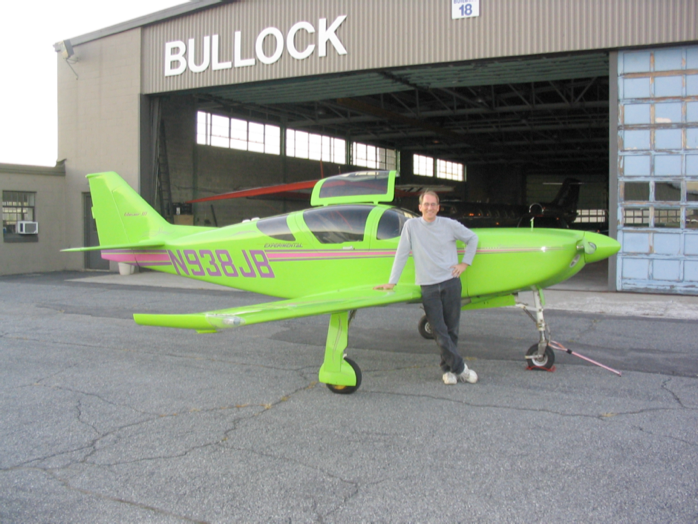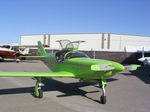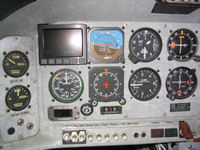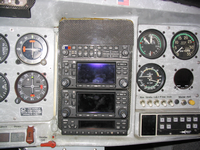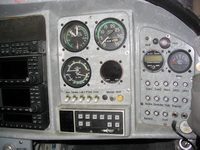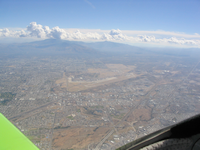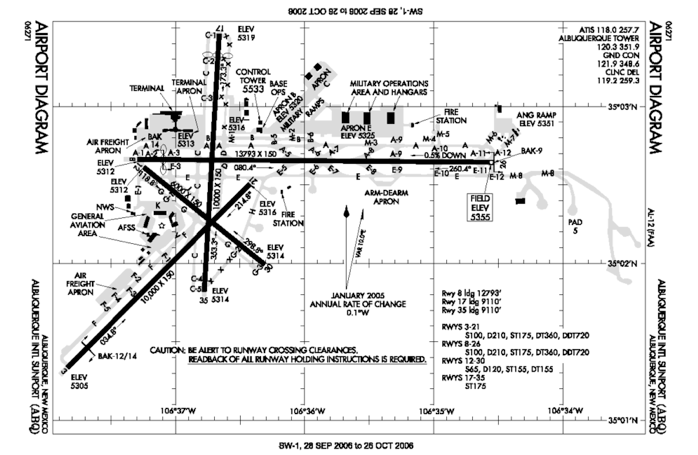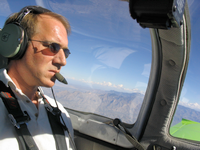Rapid Transit
In the Spring of 2006 I got the crazy idea that it was time to accelerate the RV project and the best way to do it was to sell my beloved Cardinal RG and focus. I had owned that 1979 Cessna Cardinal, which I loved, for 8 years. A couple of hangar-mates had indicated that if I was ever interested in selling it, they would be interested in buying. That spring I decided it was time. We came to a very agreeable deal quickly (sold it for just what I paid for it), and I started the "serious" building.
Very quickly I went into withdrawal. Without a plane to fly, and occasionally renting, I was lost. I needed to get my airborne fix like a drug. To satisfy that urge I started looking around, casually at first, for something interesting to fly in the meantime.
My one serious consideration was that it be at least as fast as the Cardinal. I couldn't see droning along at 110 knots in a 172. I also couldn't see paying $175K for a 15+ year old Mooney. Cirrus or Diamond were tempting, but big money for a recently used one. That left the experimental market. Scary.
I trust my own work, but I am hesitant to trust someone else's work and craftsmanship. I stumbled across Phoenix Composites. They are an assist center, but also serve to advertise third party sales and perform detailed experimental inspections and maintenance (8/21/11 - I just learned that Phoenix Composites sold all their assets to Performance One Aviation. They’re still doing business apparently). Check them out here.
They specialize in Glasair aircraft and a number are advertised with them. A Glasair. Holy crap! Aren't those things hard to fly and pilot killers? I looked into it a bit and found the accident record looked much like RVs. Plenty of trouble with low-level doinking around aerobatics, several first-flight follies, and a smattering of others, but nothing that looked too unusual for high-performance planes. No structural breakups, and no unexplained IFR overstress wreckage spinning out of the sky, a stunningly common thing for the Cessna Cardinal, by the way.
The cost was a huge factor. I am sure the builders spend much time and money on them, but on the used market they are going for $150K for reasonable examples. Definitely a bargain when nice RVs are going for $100K+.
OK Mr. Blowhard, you're saying, cut to the chase...
In the Spring of 2006 I got the crazy idea that it was time to accelerate the RV project and the best way to do it was to sell my beloved Cardinal RG and focus. I had owned that 1979 Cessna Cardinal, which I loved, for 8 years. A couple of hangar-mates had indicated that if I was ever interested in selling it, they would be interested in buying. That spring I decided it was time. We came to a very agreeable deal quickly (sold it for just what I paid for it), and I started the "serious" building.
Very quickly I went into withdrawal. Without a plane to fly, and occasionally renting, I was lost. I needed to get my airborne fix like a drug. To satisfy that urge I started looking around, casually at first, for something interesting to fly in the meantime.
My one serious consideration was that it be at least as fast as the Cardinal. I couldn't see droning along at 110 knots in a 172. I also couldn't see paying $175K for a 15+ year old Mooney. Cirrus or Diamond were tempting, but big money for a recently used one. That left the experimental market. Scary.
I trust my own work, but I am hesitant to trust someone else's work and craftsmanship. I stumbled across Phoenix Composites. They are an assist center, but also serve to advertise third party sales and perform detailed experimental inspections and maintenance (8/21/11 - I just learned that Phoenix Composites sold all their assets to Performance One Aviation. They’re still doing business apparently). Check them out here.
They specialize in Glasair aircraft and a number are advertised with them. A Glasair. Holy crap! Aren't those things hard to fly and pilot killers? I looked into it a bit and found the accident record looked much like RVs. Plenty of trouble with low-level doinking around aerobatics, several first-flight follies, and a smattering of others, but nothing that looked too unusual for high-performance planes. No structural breakups, and no unexplained IFR overstress wreckage spinning out of the sky, a stunningly common thing for the Cessna Cardinal, by the way.
The cost was a huge factor. I am sure the builders spend much time and money on them, but on the used market they are going for $150K for reasonable examples. Definitely a bargain when nice RVs are going for $100K+.
OK Mr. Blowhard, you're saying, cut to the chase...
In October of 2006 I became the proud owner of N938JB, a Lime Green 1994 Glasair III. IO-540, Dual GNS430s, and all the speed one can handle. I scoured the usual rags, websites and such. Called on a bunch, and finally went out to Phoenix in August to test fly this bird. A little more looking around, and I was back at the beginning of October to seal the deal and buy this one. Wow! Check out the spec sheet here.
I'm the third owner. The builder, Jack Bigham, now deceased, has a long string of aircraft that he built with this being his second Glasair. The second owner used it for personal transportation, and ran it up to nearly 2000 hours on the airframe. The engine is reasonably fresh with 300 hours on it and the prop. It's a proven airframe with a good motor. It's actually on the high side of hours for the design - perhaps even being the highest time example of one, so stuff to watch for is not poor construction, but long-term wear items.
This was a big step up for my flying. I contracted an instructor in Phoenix to train me up for a week. Phoenix is perfect for flying, by the way. Every day was VFR. The only problem was a couple of TFRs that popped up when Bush came to town. This thing is HOT! My first task was to learn to taxi with differential brakes. Since only the pilot has brakes, my instructor, Jim Karr, wanted to make sure we were safe in the taxi since he had no way to help out once the wheels touched down.
This was a big step up for my flying. I contracted an instructor in Phoenix to train me up for a week. Phoenix is perfect for flying, by the way. Every day was VFR. The only problem was a couple of TFRs that popped up when Bush came to town. This thing is HOT! My first task was to learn to taxi with differential brakes. Since only the pilot has brakes, my instructor, Jim Karr, wanted to make sure we were safe in the taxi since he had no way to help out once the wheels touched down.
Anyway, I felt like a moron on day one. I couldn't hold a straight line to save my life. We tried several high-speed runs down the runway - up to flying speed, then back down to a stop under control. It required my full concentration and was tough, tough, tough. Too tough, in fact, to be normal. First with the high torque trying to yank us off the left side of the runway, and the resultant correction when power was pulled. White knuckles and feet the whole time. Lots of sweat.
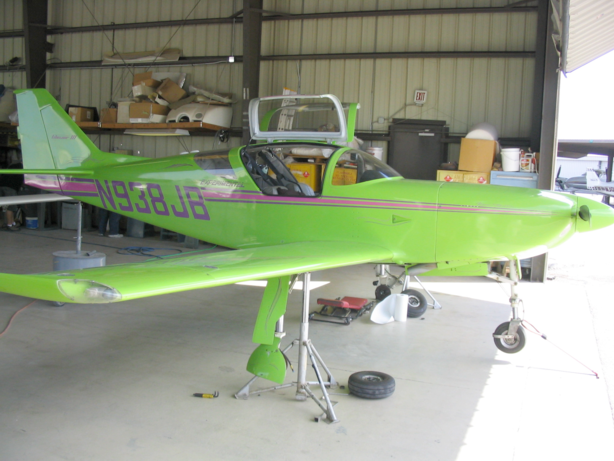
Back in the shop, the guys took the brakes apart an noticed that somewhere along the line the previous owner must have had the brakes on one side replaced. The left had 2" pistons, and the right had 3". Well, that explained the majority of my problems! Once corrected, I had a fluid leak. After that was fixed I was back in action. A full day off my schedule was spent on this stuff. It could have taken a long time had I not been at a proper shop with parts on hand and A&Ps standing by. A big thanks to the guys at Phoenix Composites. They jumped right on my work and fixed me up, knowing that my schedule was tight. However, I was starting to be glad that I had purchased a commercial return ticket in case I did not feel comfortable flying this thing at the end of my training week.
Day two finally got us flying. Initially it was flight characteristics, stalls, slow and fast flight, getting to know the instrumentation, and generally getting the feel of the plane. The first clue that this was going to be special is the THRUST. When you send that plunger in smoothly on takeoff, there is a force on your posterior pushing you forward, HARD! In cruising flight, it is a normal airplane, only you're covering ground quickly. At speed (which is about 170 knots when just playing around) the ailerons start to get stiff, but the pitch is still very sensitive. Definitely fingertips only. At low speeds things are very, very sensitive. The ailerons get much lighter. The astute viewer might notice that I have the long wings, and the builder extended the ailerons the entire length with spades for balance. I can't speak for all Glasairs, but this one handles nicely with the forces increasing quite linearly. Without spades I am guessing it would be very, very stiff in roll and much lighter in pitch.
At the end of the second day and into the third we started on landings. Wow. It lands fast. Jim Karr impressed upon me that slow=dead. It sinks like a stone when the power is pulled. When the the junk is hanging out it's even worse. Whereas in the Cardinal I had learned that landings can be finessed with power and balance to squeak it on almost every time, the Glasair can not be finessed as delicately. If there is ANY hint of excessive sink or it looks at all like I'm short, it's much better to swallow the pride and go around than to risk a short landing, a plunker, or worse. After my first round of landings, I was sure that there was no way in hell that I was going to be ready to fly this thing home myself at the end of the week.
Day three was more landings and some emergency procedures. Things started to click a little, but I was still behind the aircraft on many occasions. Speed management came into play. You have to plan your decent way out to get to the pattern on altitude, speed, and power. Jim emphasized that if you charge into the pattern hot, there is no way you're going to be able to recover and slow the thing down in time. At 5 miles out you should be 500 to 1000 feet high and slowed to pattern speed (140MPH) in order for things to work out. Patterns are close in and 120MPH in order to work. This is a by-the-numbers airplane.
Day four. More landings. We did 78 landings in 3 days. At the end of the fourth day I was actually feeling minimally competent. At the end of the day, the inevitable happened, Jim hopped out and had me do 3 laps on my own. I haven't felt nervous like that since my student days. After the sheer number of landings we did, though, it was completely uneventful. They may actually have been my best ones yet. I thought I was ready. Not comfortable, mind you, but ready.
Day five I spent having the shop guys take care of some electrical nuisances, and put in a new battery. They actually took care of a whole bunch of little things between our flying sessions. I decided that I was going to have everything I could think of done to the plane since I was there and they were familiar. I can't say enough good things about Heath, Rob, Troy, and the other guys at Phoenix Composites. Buying this class of airplane would be extremely difficult for a newbie without their help. I spent my time flight planning. It had been a while since I had flown a long cross country - totally VFR. This is a new plane, and I was not going to even think about any IFR until I have much, much more experience, even though I was technically IFR current.
Saturday 10/7/06. Go time. A new high performance plane. Crossing the Rockies, and the longest cross country I have embarked upon were in front of me. Understatement: The nerves were a little tight.
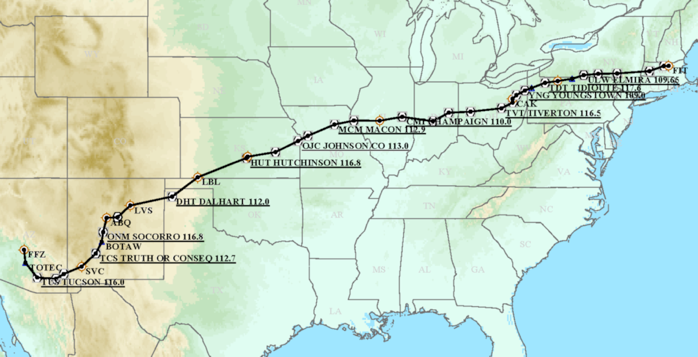
Initially I took the southern route passing over Tucson and up over Truth or Consequences and into Albuquerque. This kept me out of the tallest of the mountains. I never had to get over 11000 feet to stay comfortably over the mountains.
I hadn't realized it during planning, but my route took me directly over Davis Monthan Air Force base, the Boneyard. In the photo the big field areas adjacent to the strip are the storage areas. Some day I'd like to take a tour of the derelicts up close.
No time to linger, though. My first stop was Albuquerque. Landing was no issue. Takeoff, now that was a new experience. As can be seen in the diagram, the field elevation is 5500 feet. The temperature was about 85 degrees. Talk about high density altitude. I took off from runway 12. Now here is where I would have gotten into trouble in a lesser plane. I'll admit that with 6000 feet of runway I was not as concerned as I should have been with all my new performance, but wow! When I lifted the nose nothing happened. Usually it runs on the mains for a second before lifting off. This time it ran and ran and ran before lifting off and then squashed along for another 1000 feet before solidly climbing.
No time to linger, though. My first stop was Albuquerque. Landing was no issue. Takeoff, now that was a new experience. As can be seen in the diagram, the field elevation is 5500 feet. The temperature was about 85 degrees. Talk about high density altitude. I took off from runway 12. Now here is where I would have gotten into trouble in a lesser plane. I'll admit that with 6000 feet of runway I was not as concerned as I should have been with all my new performance, but wow! When I lifted the nose nothing happened. Usually it runs on the mains for a second before lifting off. This time it ran and ran and ran before lifting off and then squashed along for another 1000 feet before solidly climbing.
After takeoff, ATC kept me low and heading south for crossing traffic. This was a little alarming since there was a mean looking cell building south of the airport. I kept on my heading until I was sure they had forgotten about me. Sure enough, as soon as I called back they immediately lifted my restrictions and cleared a turn away from the cell. Almost simultaneously there was a huge bolt of lighting that looked to be no more than a couple of miles to my right. Every radio crackled for several seconds afterwards. I got out of there real quick!
Once I cleared the last few lines of hills east of Albuquerque it started to clear up and I was graced with severe clear VFR the rest of the way to Massachusetts. Next stop in Hutchinson, Kansas with an overnight. From there an early start to Springfield, IL, Akron, Ohio, then on to Fitchburg, MA. Total air time was about 9.5 hours. Average ground speed was 220 knots.
So now I own a Glasair III. I've only been up a couple of times since my cross country. The performance is stunning. It's still intimidating, but now in a manageable sort of way. Being on my home turf definitely is confidence inspiring and I'm sure that it will get to feel more routine - and I am sure I'll get spoiled by the performance.
